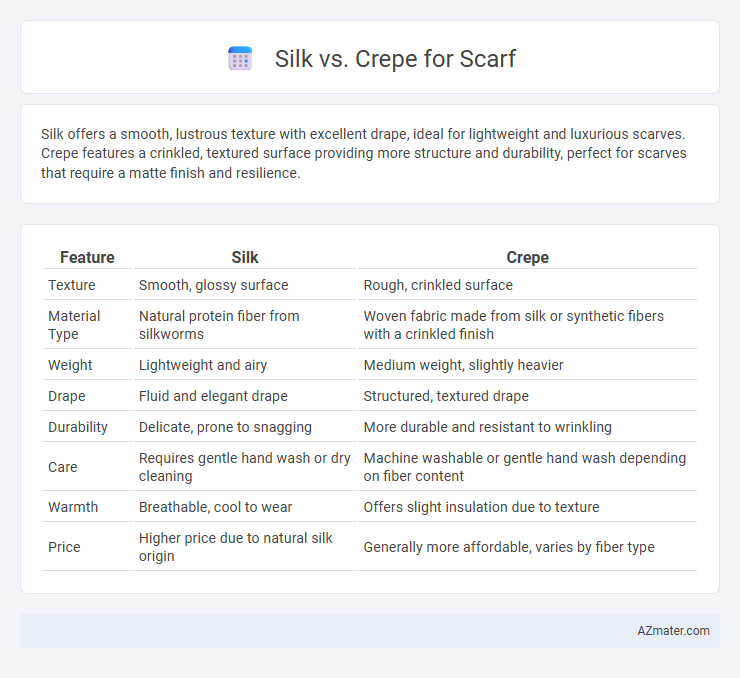Silk offers a smooth, lustrous texture with excellent drape, ideal for lightweight and luxurious scarves. Crepe features a crinkled, textured surface providing more structure and durability, perfect for scarves that require a matte finish and resilience.
Table of Comparison
| Feature | Silk | Crepe |
|---|---|---|
| Texture | Smooth, glossy surface | Rough, crinkled surface |
| Material Type | Natural protein fiber from silkworms | Woven fabric made from silk or synthetic fibers with a crinkled finish |
| Weight | Lightweight and airy | Medium weight, slightly heavier |
| Drape | Fluid and elegant drape | Structured, textured drape |
| Durability | Delicate, prone to snagging | More durable and resistant to wrinkling |
| Care | Requires gentle hand wash or dry cleaning | Machine washable or gentle hand wash depending on fiber content |
| Warmth | Breathable, cool to wear | Offers slight insulation due to texture |
| Price | Higher price due to natural silk origin | Generally more affordable, varies by fiber type |
Introduction: Understanding Silk and Crepe
Silk scarves, made from natural protein fibers produced by silkworms, offer a smooth texture and lustrous finish prized for luxury fashion. Crepe scarves, crafted from various fibers like silk, wool, or synthetic materials, feature a distinctive crinkled texture that adds depth and versatility to designs. Understanding the unique fiber composition and weave structure of silk and crepe helps in selecting scarves that balance elegance, durability, and comfort.
Fabric Origins: What is Silk?
Silk is a natural protein fiber produced by the larvae of the silkworm, primarily the Bombyx mori species, through a process called sericulture originating in ancient China over 5,000 years ago. Known for its smooth texture and natural sheen, silk fibers are composed mainly of fibroin, which provides strength, elasticity, and a luxurious feel ideal for scarves. Its production involves harvesting silk cocoons, boiling them to extract continuous filaments, and then weaving these fibers into lightweight, breathable fabric prized in fashion and luxury accessories.
Fabric Origins: What is Crepe?
Crepe fabric originates from a weaving technique that creates a crinkled or pebbled texture, traditionally made from silk but now also woven from wool, cotton, and synthetic fibers. Its name derives from the French word "crepe," reflecting the fabric's distinctive grainy appearance created by tightly twisted yarns. This textured surface distinguishes crepe scarves from the smooth, lustrous finish of pure silk scarves, offering a more matte and tactile feel.
Texture and Feel: Silk vs Crepe
Silk scarves offer a smooth, luxurious texture with a glossy finish that feels cool and soft against the skin, ideal for an elegant, lightweight accessory. Crepe scarves provide a slightly crinkled, matte texture with a more substantial, breathable feel, enhancing durability and a sophisticated drape. The choice between silk and crepe depends on the desired tactile experience, with silk emphasizing softness and sheen, while crepe delivers textured richness and resilience.
Appearance and Aesthetics
Silk scarves exhibit a smooth, lustrous surface with a natural sheen that enhances vibrant colors and intricate patterns, creating an elegant and luxurious appearance. Crepe scarves feature a textured, crinkled finish that offers a matte look and adds depth, making them ideal for casual or understated styles. The glossy shine of silk contrasts with the subtle texture of crepe, influencing the overall aesthetic and draping qualities of the scarf.
Durability and Longevity
Crepe scarves, made from tightly woven fibers with a crinkled texture, offer superior durability compared to smooth silk, resisting wear and tear more effectively. Silk scarves, while luxurious and smooth, are more prone to snags, abrasion, and fading over time due to their delicate natural fibers. For lasting use, crepe provides enhanced longevity, maintaining its texture and color through frequent wear and washing better than traditional silk fabric.
Breathability and Comfort
Silk scarves offer exceptional breathability due to their natural protein fibers, allowing air circulation and moisture absorption, which keeps the skin cool and comfortable. Crepe scarves, made from tightly twisted fibers, provide a slightly textured feel that adds warmth but reduces airflow compared to silk. For optimal comfort in warmer climates, silk is preferred for its lightweight and breathable characteristics, while crepe suits cooler conditions due to its insulating properties.
Color Retention and Print Quality
Silk scarves exhibit superior color retention due to their smooth, non-porous fibers that hold dyes vibrantly over time, maintaining rich and lustrous hues even after repeated wear. Crepe fabric, characterized by its slightly textured surface, absorbs dye differently, which can result in softer, more muted prints but often offers excellent print clarity and intricate detail definition. When choosing between silk and crepe for scarves, silk delivers bright, enduring colors ideal for bold patterns, while crepe provides subtler tones with a delicate print quality suited for intricate designs.
Care and Maintenance
Silk scarves require gentle hand washing with mild detergent and should be air-dried away from direct sunlight to preserve their natural sheen and delicate fibers. Crepe scarves, often made from polyester or wool, are more durable and can typically withstand gentle machine washing or dry cleaning without losing texture. Proper storage in a cool, dry place prevents wrinkles and extends the lifespan of both silk and crepe scarves.
Choosing the Best Scarf: Silk or Crepe?
Silk scarves provide a luxurious feel with natural sheen, exceptional softness, and excellent breathability, making them ideal for elegant, lightweight accessories. Crepe scarves offer a textured, matte finish with greater durability and wrinkle resistance, perfect for more structured styles and daily wear. Choosing between silk and crepe depends on desired texture, care preferences, and occasion versatility.

Infographic: Silk vs Crepe for Scarf
 azmater.com
azmater.com